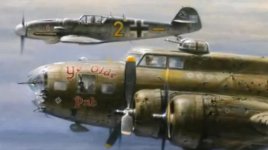Just read this amazing story that took place back in WWII and thought I would share it here...
Why A German Pilot Escorted An American Bomber To Safety During World War II
It was a few days before Christmas in 1943, and the Allied bombing campaign in Germany was going at full tilt. Second Lieutenant Charlie Brown was a freshly minted bomber pilot, and he and his crew were about to embark upon their first mission — to hit an aircraft factory in northern Germany.
Brown's B-17F Flying Fortress, dubbed Ye Olde Pub, was typical of American heavy bombers of the time. Along with an 8,000-pound bomb capacity, the four-engine plane was armed with 11 machine guns and strategically placed armor plating. B-17s cruised at about 27,000 feet, but weren't pressurized. At that altitude, the air is thin and cold — 60 degrees below zero. Pilots and crew relied upon an onboard oxygen system and really warm flight suits with heated shoes.
As Ye Old Pub approached Bremen, Germany, German anti-aircraft batteries opened up on the formation. Unfortunately for the pilots and crew of Ye Olde Pub, one of the anti-aircraft rounds exploded right in front of their plane, destroying the number two engine and damaging number four. Missing one engine and with another throttled back due to damage, Ye Olde Pub could no longer keep up with the formation.
B-17s were known for being able to soak up a lot of bullets and anti-aircraft flak and still make it home, but that came at a cost. The armor plating protecting crew and vital areas of the plane was heavy and affected cruise speed. Although armed with a number of heavy machine gun turrets, there were still areas of the aircraft that were vulnerable to attack by enemy fighter planes. The U.S. Army Air Corps addressed this problem by placing many planes in staggered formation that allowed bombs to be dropped while multiple planes could cover the defensive gaps of other planes in the formation with overlapping fields of fire.
The drawback to this arrangement was that individual planes couldn't take evasive maneuvers (they'd risk damage from friendly bombs or machine gun fire), and stragglers were completely open to attack by enemy aircraft. Think about a small group of quick, agile cowboys chasing a herd of buffalo. They're both dangerous to one another, but if one lumbering buffalo leaves the safety of the group, there's not much hope for it.
Things went from bad to worse for Brown and his crew. Falling behind the formation, Ye Olde Pub weathered merciless attacks from 15 German fighters. The bomber's machine guns got one of them, but the damage they sustained was immense. The tail gunner was killed and four were injured, including Brown, who caught a bullet fragment in his right shoulder. The only defensive guns left in service were the top turret and the nose gun, and the bomber's hydraulics and oxygen systems had also been knocked out. The plane went into a spiral, plummeting earthward.
What happened next is according to the memory of Brown, who told interviewers years later that his mind was a bit hazy at the time; his shoulder was bleeding and he needed oxygen...
Read the whole story here:
http://jalopnik.com/5971023/why-a-g...to-safety-during-world-war-ii?tag=Planelopnik

